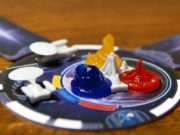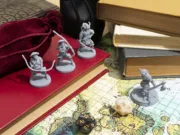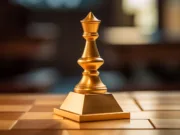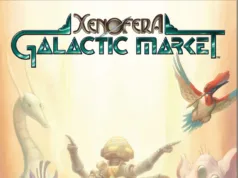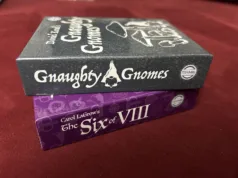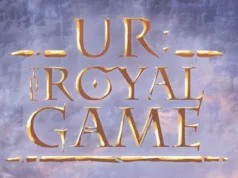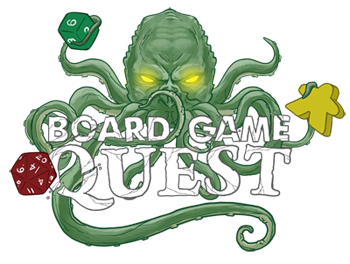Note: This preview uses pre-release components and rules. What you see here may be different from the final, published game.
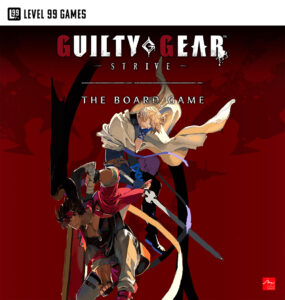 It’s been quite a while since I’ve played one of those side-scrolling fighting games. I grew up in the arcades playing Mortal Kombat, Killer Instinct, Soul Caliber, Injustice, and Street Fighter. Since then, I’ve lost my twitchy finger skills and have kind of fallen out of the genre.
It’s been quite a while since I’ve played one of those side-scrolling fighting games. I grew up in the arcades playing Mortal Kombat, Killer Instinct, Soul Caliber, Injustice, and Street Fighter. Since then, I’ve lost my twitchy finger skills and have kind of fallen out of the genre.
So when a demo deck of Guilty Gear: Strive – The Board Game landed on my doorstep, I immediately called up fellow review Brian to see if he knew anything about this anime show. He quickly corrected me that it’s a video game franchise (although much less politely, thanks Brian) in the same vein as those battling games. Today I Learned…
Theme aside, Guilty Gear: Strive – The Board Game is actually the newest game in Level 99’s Exceed Fighting system. I’ve lost track of how many Exceed games have been released, but I think it should be fully compatible with all previous Exceed games.
Gameplay Overview:
Guilty Gear is a 1v1 fighting game, much like its video game counterpart. The goal is to be the first player to reduce their opponent’s hit points to zero. The demo deck of Guilty Gear featured two characters: Sol Badguy and Ky Kiske.
Each player starts with a hand of seven cards, and on their turn, they can take 1 action. There are some minor things you can do with your actions, such as drawing a card, moving along the board, or flipping to your Ex side. However, the main thing you’ll be using cards for is to either Strike or Boost power.
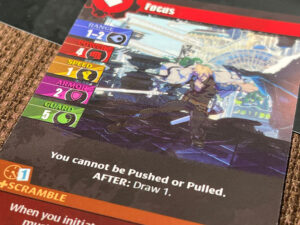
To Strike, you play a card face down and your opponent does the same. Cards are revealed and the player with the higher speed gets to strike first. Each attack has a range and a power. Damage is applied, minus any armor from the opposing card. Many cards also have special abilities that fire off before, during, or after the attack. If the defender has a high enough guard on their card, they get to strike back after the first attack was resolved. If not, they are stunned and must discard their played attack card. Any successful attacks send the resolved card to the player’s gauge meter. Gauge is a resource that can be spent to play cards or upgrade your character to their EX side.
Instead of playing a card for its Strike ability, you can alternatively play it as a boost. There are both instant boosts and continuous ones. The continuous ones usually will boost your next attack (a plus to damage, speed, etc…) and are discarded after your next strike is resolved.
At the end of your turn, you draw a card, but only if you didn’t strike on your turn. Then the next player gets to go.

Gameplay Impressions:
I was quite impressed with the demo decks of Guilty Gear. Knowing nothing about the video game franchise, and having played Exceed only once many, many years ago, I basically went into the game fresh. Yet to this new set of eyes, I feel like it does a great job of capturing the spirit of the 2D fighting game on your tabletop.
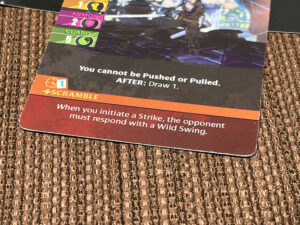
One interesting mechanic in the game is the ability to “cancel” a boost card to take another action. Many times you play a continuous boost to get a bonus to your next attack, and then immediately make a strike action. I’ll admit though, at first we were baffled by the cancel mechanic. While the rulebook is very clear that the card you “cancel” still fully resolves, I had to get some clarification on that phrase.
According to designer David Talton, “‘Cancel’ is a video game term from Guilty Gear. In the video games, ‘canceling’ allows you to skip the cooldown of an action and immediately take another action.” This makes a lot more sense and I appreciate how they worked the video game logic into the tabletop game.
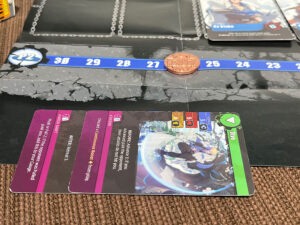
The fast-paced nature of Guilty Gear also leads to quick matches with lots of damage. While each player had a couple of defensive/block cards, for the most part, all of your attacks are going to do some damage. However, thanks to the dual-strike nature of the gameplay, one player rarely gains a health advantage. Almost all of our tests came down to the very end of the game. More often than not, strategically playing your cards won the day.
With only two characters, it was hard to get a sense of variety in the game. Sol and Ky didn’t feel all that different, in fact, other than their special ability, they only have about 6 or so cards different between their decks. I’m sure the full game will offer up a lot more variety, but we’ll have to wait and see on that one.
Final Thoughts:
With the demo decks, we only scratched the surface of the game. I believe the Kickstarter is going to have some 20 characters, so there is a lot more to check out with Guilty Gear: Strive – The Board Game. I really enjoyed its fast paced, back-and-forth gameplay, and it definitely pulled in the spirit of the 2D fighting games. We brought our demo deck to Gen Con this year and everyone we played it had a good time and was interested in exploring the game more. While the Guilty Gear theme doesn’t do anything for me, I still look forward to giving this one a deeper look once it’s funded and published. And who knows, maybe someday we’ll get a Mortal Kombat or Soul Caliber theme.
If you are interested in finding out more about Guilty Gear: Strive – The Board Game be sure to check out Level 99 Games newly launched Kickstarter campaign.




